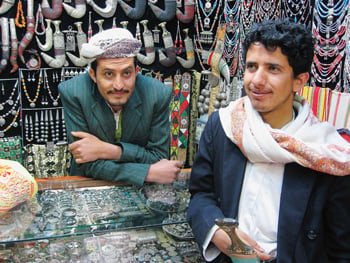All my adult life I have collected silver jewelry from the Middle East. It began in 1960,
when I received a grant to spend the summer studying Arabic in Lebanon. From there I visited
Damascus, and I went home with my first bracelet. Later, throughout a 30-year diplomatic career,
I collected jewelry. At first it was just to wear, but as my husband, David, grew as interested
in silver as I, we bought larger and more complex pieces. By 2000 we had accumulated a
significant collection.
 |
|
Silversmith Ali Muttahar al-Ma'amari, left, is among the new generation of silversmiths from
al-Rujum, west of Sana'a. At right is his cousin, Walid al-Ma'amari.
|
Through forays to jewelry markets around the Mediterranean and throughout the
Arabian Peninsula, I learned that the most intricate jewelry came from Yemen.
I found good Yemeni pieces in Jiddah, Damascus, Cairo and, on rare occasions,
in the us. As time went on, I focused my attention
more and more on Yemeni silver, not only because of its unsurpassed craftsmanship,
but also because, by the late 1990's, it looked as if this traditional craft
might disappear.
This threat had its roots in the decline of both demand and supply. Gold had
risen in value over the previous few decades, reducing the relative value of
silver, and silver thus became too inexpensive to serve as a depository of family
wealth, as it had for centuries. At the same time, even the idea of keeping wealth
in such a form became old-fashioned as banks became more accessible. For those
families who did retain some wealth in the form of jewelry, gold became the metal
of choice, even if a family could afford only a piece or two. Lifestyles changed,
too: Instead of receiving jewelry as wedding gifts, as was traditional, new couples
often preferred appliances. And of the silversmiths, many of the most skilled had
been Jews, and in the late 1940's and early 1950's, most of Yemen's Jewish
population emigrated to Israel.
In the early 1990's, I began to lecture on Yemeni and Middle Eastern jewelry,
and I arranged the exhibition "Silver Speaks: Traditional Jewelry of the Middle
East" in 2004. After I addressed the Freer Gallery Seminar on Yemeni Culture in
2002, Abdul Karim al-Iryani, then a special advisor to the president of Yemen,
encouraged me to research and write more on Yemeni jewelry. A year and a half
later, thanks to research support from the American Institute for Yemeni Studies,
I was on my way back to Yemen, and between 2005 and 2007, I spent about a year
there.
That is when, to my delight, I found that a new, young generation of
silversmiths had grown up. Despite the difficulties of low demand and, most
recently, political turmoil, they are keeping the traditional craft of finely
worked silver alive. I sought out and spoke with about 40 of them.
In particular, a group or "school" of young men from al-Rujum, north of Sana'a,
had been receiving encouragement from their fathers to learn silversmithing. Silver
was cheap, it seemed, so they could melt down their mistakes and resell the bullion
without major losses. To a person, these young men are proud to be continuing one of
their country's finest artisanal traditions—and willing to face a new, uniquely
21st-century, challenge: Sana'a markets are full of Chinese tin-and-plastic copies
of Yemeni traditional jewelry.
There is, however, a market for their best work in Saudi Arabia. A fine hand-tooled
sword of 85 percent silver might bring as much as $2500; a new woman's belt done in
filigree might bring $1000. (A good antique one might fetch up to $3000.) A few
families in Sana'a have purchased complete new sets of wedding jewelry in the
traditional style. Tourists, when they come, buy the new work, too. But most of the
silversmiths agree that, if these crafts are to thrive again, there will have to be
more customers.
 |
Collector, curator and writer Marjorie Ransom (maransom@verizon.net) first showed her collection of traditional Middle Eastern silver jewelry in 2003 in Washington, D.C. It has since appeared in solo and group shows in New York, San Diego and at the Arab American Museum in Dearborn, Michigan. A book, Silver Treasures from the Land of Sheba, has been accepted by the American University in Cairo Press. |